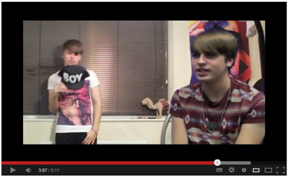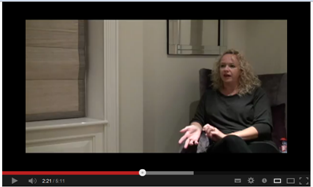In what ways does your media product use/develop/challenge forms and conventions of real media products?
I am firstly going to talk about the way our interviews were structured and portrayed within the documentary. Throughout the documentary we filmed and used five different interviews, all of which had different settings, people and focuses.


In this part of the interview we decided to put multiple flashing images of Chris with his merchandise in the background as this is what he is talking about. This shows the audience the merchandise he has as well as Chris talking about the merchandise.

Overall I think Chris’ interview went well, we spent the most time on this interview as it took a lot to edit, put in the background on the blue screen and alternating different images to support what Chris was talking about. After we had finished we thought we had structured the interview well including the conventions of real media products such as the rule of thirds and having different images using a variation of transitions to emphasis and support what the interviewee is talking about.
 For holly’s interview, rather than using the blue screen, we set up the room to cater for who her role model was and the types of things she was talking about, so because Holly was talking about the rich and glamorous Sarah Jessica Parker, we filmed her interview in a posh, clean and glamorous room. Therefore there was not as much editing to do on this interview as there was to do on the others.
For holly’s interview, rather than using the blue screen, we set up the room to cater for who her role model was and the types of things she was talking about, so because Holly was talking about the rich and glamorous Sarah Jessica Parker, we filmed her interview in a posh, clean and glamorous room. Therefore there was not as much editing to do on this interview as there was to do on the others. We also have an image to support what holly is talking about whilst she is still speaking, this image dissolves in and out over 2 seconds.
Holly’s interview, in my opinion was the best in terms of the set up, the mise en scene and the style of the interview itself as it matched who she is and what she was talking about, therefore it is easier for the audience to grasp the kind of person she is and also helps them understand the way she lives her life.

For the psychologist’s (Gemma’s) interview, of which we filmed in the blue screen room, we thought this was not the best decision as we were unsure as to what to use as the background because she focuses on generic points to do with young people having role models, and doesn’t have a definitive subject view, like the other interviews had.
So we decided to use the general media for the background, filming lots of different magazines to put behind Gemma, once we had done this, we realised it didn’t look to bad and actually suited with what Gemma was talking about.
Gemma talks about how young people need somebody to look up to, to guide them, and how we live in a competitive society in terms of things being shown in magazines and on the television of which is influencing children.
 For Jen’s interview we wanted to set up the mise en scene in a way that made it look formal and sophisticated as she is a concerned parent. Therefore we had her sit on an armchair, using rule of thirds, talking to the left of the camera, making sure she was eye-level with the camera but looking at the interviewer. This worked very well as it turned out to be a very formal interview. Here, are the images we used to support Jen’s views.
For Jen’s interview we wanted to set up the mise en scene in a way that made it look formal and sophisticated as she is a concerned parent. Therefore we had her sit on an armchair, using rule of thirds, talking to the left of the camera, making sure she was eye-level with the camera but looking at the interviewer. This worked very well as it turned out to be a very formal interview. Here, are the images we used to support Jen’s views.Jen talks about how Kate Moss is a bad role model for young people, we took this opportunity to include some footage of Kate Moss and the bad things that she actually did, as Jen does not go into full detail.
This is another image we used as Jen talks about how after Kate’s behaviour she just gets re-branded as the face of Rimmel, which is not a good message for children.
Jen also talks about Chris Brown, and how he is a bad role model for abusing his girlfriend, Rihanna. We put in a picture to give the ‘shock factor’ to the audience, to make the documentary more interesting.
 Overall, Jen’s interview went really well, and we got across the view of Jen being a concerned parent with the combined efforts of setting up the mise en scene in a professional, sophisticated way and Jen’s opinion.
Overall, Jen’s interview went really well, and we got across the view of Jen being a concerned parent with the combined efforts of setting up the mise en scene in a professional, sophisticated way and Jen’s opinion. 
All of our interviews follow the forms and conventions of real media products. We used rule of thirds and use of b-roll footage. We also included a montage during Chris’ interview as he speaks.
For our documentary we also had a voice over of which we recorded and embedded over the visual documentary, the voice-over talked about some of the role models, introduced the interviewees in a variety of ways and helped the documentary flow nicely. This voice acts as the ‘voice of god’.
In terms of filming, we created an introduction to Holly and her lifestyle. We did this by having Holly walk to her car outside her big house to show the kind of life she lived. We did this in an effective way to keep the audience wanting to watch. We filmed using plenty of different angles including establishing shot, over the shoulder shot, point of view shot and over head shot.
In conclusion, I think we did well in using, developing and challenging the forms and conventions of real media products to make our documentary look as professional as possible.






No comments:
Post a Comment